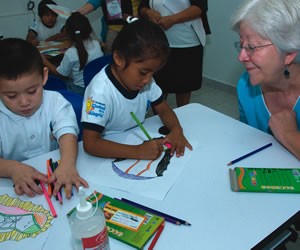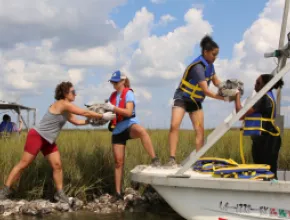When Odyssey Teams created Habitat for Hounds about a decade ago, CSR (corporate social responsibility) was barely a blip on the corporate radar screen. Fashioned as a spinoff of Habitat for Humanity, meeting attendees built dog houses and auctioned them off, with proceeds going to a local SPCA.
The activity drew rave reviews from attendees as both a training simulation and way to benefit the local community.
"About 10 years ago, we realized activities and simulations were great at highlighting and drawing out behaviors of teams and leadership," says Bill John, president and CEO of Odyssey Teams, founded in 1991 and based in Chico, Calif.
But up to that point, according to John, many of its team-building activities were hypothetical in nature and left nothing tangible to show for the efforts of the attendees.
"We said if what we built had some meaning to the community, it would have more leverage as a leadership and teaming experience," he says.
Alcatel-Lucent USA, Inc., which had participated in Habitat for Hounds, requested more community service options.
"We put our heads together to see what else we could do," John says.
The challenge gave birth to Odyssey’s Life Cycles program, the first bicycle building activity used in a training capacity, and the first time children appeared on-site during a meeting to receive them. Since then Odyssey’s programs have facilitated the building of over 13,000 bicycles for kids all over the world.
"We’re really proud of that, because in addition to 13,000 bikes we really changed our whole industry," John says. "That started programs under the umbrella of team building, recognizing that old experiences and simulations were inadequate if they didn’t somehow connect to community."
The company also is known for its Helping Hands project, where attendees help build prosthetic hands, which are distributed worldwide.
According to CSR expert and motivational speaker Tim Sanders, author of Saving the World at Work (Doubleday), the past 10 years have brought nothing short of a "responsibility revolution" in how companies approach CSR.
"The social responsibility and green business movement has been bubbling up since 2002 or so—think Enron backlash meets Al Gore/Bono," Sanders says. "After Katrina, many players integrated community service as a way of elevating the meeting’s meaning. The recession of 2008 to 2009 caused planners to focus on the economy, surviving, innovating, saving, etc.—all short or mid-term strategies."
According to Sanders, CSR is once again evolving as an integral part of the meeting experience.
"Over the last six months, I’m seeing meetings begin to integrate cause, CSR, sustainability and community topics/exercises into meetings," he says. "This is especially true when the companies or associations still list CSR/sustainability as a top priority in their annual reports."
Publicis Meetings USA, a full-service meeting management, logistics and events company headquartered in Orlando, Fla., also sees increased demand for CSR meeting components, with many organizations incorporating CSR community service activities in lieu of or in addition to tours or other group outings.
Another popular trend is incorporating CSR into a team-building event at the meeting location. Off-site activities the company facilitates include volunteering at a food bank, while on-site options include packing care boxes for troops in Afghanistan, assembling oyster mats to help with oyster reef restoration and filling backpacks for local schools in need.
Donation stations at trade shows are also becoming more popular, allowing attendees and exhibitors to donate their leftover trade show bags and giveaway items to local organizations.
"I’ve noticed as far as activities, groups are adding more CSR options in addition to spa and golf and shopping," says Erin Cook, associate director of business development for Publicis Meetings USA. "I can definitely see the difference since times have gotten hard—there is more incentive to implement CSR. Also, from a PR standpoint, companies want to look good. It helps with morale; people want to work for a company they respect. I would say it’s the economy and perception issues, a combination of both."
Cook is also on MPI’s CSR committee for its World Educational Congress scheduled for Orlando in July. CSR is a primary focus for the meeting, according to Cook, including at least three off-site options and several on-site options.
Lucy Eisele, owner of Integrity Incentives based in Big Lake, Minn., also sees a stronger trend for CSR at meetings, but is concerned that some of it could be superficial.
"It seems more companies are getting on the bandwagon, I assume because of perception more than anything," she says. "I worry that programs, especially incentives, will become diluted with companies and planners adding them just to say they did a give-back.
"My company continues to take the approach of tying in the activity to the entire program—in some way, shape or form," she continues. "Implementing CSR activities is a lot of extra work, and many planners don’t have the staff or know-how, so are settling for the easier give-backs."
Odyssey Teams also focuses on connecting the activity with a broader goal of the meeting.
"The focus can’t be entirely on the philanthropy," John says. "In order for a CSR event to be successful people have to understand the broader connection. It doesn’t work well to send groups out to do something without having a discussion or dialogue on how it all connects to the work we do, challenges we face and where we’re going.
"We help answer those questions and connect those dots," he continues. "Before we do programs, we’re on the phone with clients and find out what are the challenges, values and behaviors that you think will have the greatest impact on your people and company and how can we leverage that to benefit them and the community."
Companies are looking at ways to measure the benefit of CSR. MPI recently rolled out its Sustainable Event Measurement Tool, which measures and reports the environmental and social impact of events and business.
NBTA also released a CSR Toolkit last July, available on the NBTA website. That toolkit is broken up into several chapters, including an entire chapter guide to hosting responsible meetings that includes information about "volunteerism" and calculating a footprint.
"This is targeted toward travel managers—anyone in the travel industry who has any influence or commitment to sustainability in travel," says Robert Wade, chair of the NBTA CSR committee.
The committee was formed because of a demand for a more focused set of information around CSR, according to Wade. "When we formed four years ago, there wasn’t a clear definition of what CSR is. We looked at voluntourism from a standpoint of how you can, while you’re traveling, have an effect on the community you are traveling to—what CSR activities might be available."
In the sourcing process it is possible to plan a meeting where a large Habitat for Humanity project is going on, for example. At NBTA’s convention last year in Houston, members were invited to participate for a half day helping paint at a homeless shelter and the response was overwhelmingly positive from attendees, according to Wade.
"People are much more impacted by the sweat equity than they are the cash donation," Wade says. "Those are the programs I hear the most about from people."
Wade says that though NBTA does not specifically measure the ROI of a service program, "ROI really comes in employee satisfaction. How did my being able to help someone make me feel and how does it make me feel about my company that they facilitated that?"
The NBTA toolkit does not yet address how to vet a service project, though Wade says that the organization is looking into that option for a later version.
"I think that there is probably common sense stuff," he says. "You can Google them, check their financials, how long have they been in service, do they have a reputation? I recommend folks start with bigger organizations."
Planners can call United Way and ask if they have anyone in the area they recommend to participate with, or call a local church group, Wade suggests. Other options are contacting local food banks, Boys & Girls Club of America, Salvation Army, Habitat for Humanity, or checking the website http://voluntourism.org to see what projects are available in a specific region.
"The CVBs might have some suggestions," Wade says. "It’s becoming a hot enough topic they probably would have lists of service opportunities."
According to speaker and author Sanders, an increasing number of planners are making hotel and destination choices based on the CSR opportunities they offer.
"Here is what is growing in meetings related to suppliers and destinations: The rise of the CSR/Sustainability score card," he says. "This idea is spreading to hundreds of major corporations that now grade all suppliers, especially high-profile destinations, to prove they are investing in local community, have fair trade products available and practice environmental sustainability. Score low, and it’s a hit on your chances just like a lack of amenities or a price that’s too high."
Sanders adds that CSR is proving to be a useful tool for companies to counter perception issues related to meetings.
"The public is still whipped up into a frenzy over executive pay and lavish corporate meetings," he says. "If you can point to all your meeting ingredients and say, ‘We are doing business with companies that care, teaching a business ethics message and saving the environment,’ you may be able to actually have your annual meeting at a sunny, well-appointed destination without raising eyebrows inside or outside the company."







